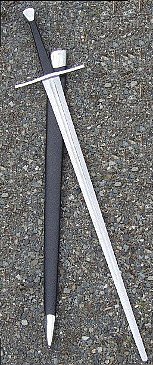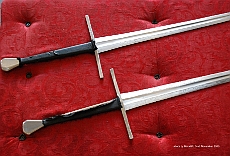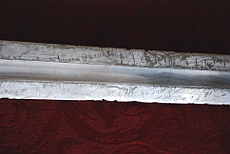
Assessment and Review of Tinker Pearce Blunt Longsword Trainer
by David M. CvetNovember 10, 2009
Background
The Academy of European Medieval Martial Arts or AEMMA[ 1 ] has as its purpose is the reconstruction and resurrection of medieval martial arts, specifically medieval Europe for the period between the 14th to the 15th centuries. The last decade saw AEMMA focused on 14th and 15th century historical Italian treatises such as Fiore dei Liberi[ 2 ] who had authored "Flos Duellatorum" in 1410, one of four versions known to exist, and which describes a comprehensive training system encompassing grappling, dagger, armoured and unarmoured longsword, spear, pollaxe and mounted training.
 |
| A depiction of Oakshot's type XIIa |
 |
| The Tinker blunt longsword trainer |
Blade Properties
Tinker's swords are constructed 5160 marquenched spring steel tempered to 50-53 Hrc whereas the tang is drawn back to the low 30s Hrc. The tang's end is threaded to fit an allen nut recessed into the pommel which allows for quick dismantling of the hilt assembly in order to examine the condition of the blade or to fit the sword with an alternative or customized set of "furniture". It is assumed that the composition and hardness are consistent throughout the blade, as opposed to hardened edges and a lower hardness factor for the "body" of the blade. The production of these swords were done in China, but the review and acceptance of the production was done by Tinker Pearce to ensure that the quality of the swords were consistent with Tinker's wish. The blades were noted as being strong and flexible blades being able to bend the blade almost 90 degrees to which it would spring back to its original straight shape. This attribute is extremely important for the gioco stretto plays which surface during the bouts at AEMMA, and also, given that thrusting is permitted in the bouts, the flexibility allows for relatively safe thrusts.
The Assessment Environment
AEMMA recently purchased a pair of Tinker longswords (SH2395 Longsword - Tinker Pearce Blunt Trainer) and used this pair in a recent unarmoured tournament, Saturday, November 7th (a review of the unarmoured tournament can be view on the AEMMA blog at "3rd Annual Unarmoured Tournament in Review"). We had decided to put the swords through their paces in the tournament to determine their viability as a "standard" training weapon in the training and fencing environment at the Academy. Briefly, the tournament was comprised of 12 combatants of individuals from Toronto, Guelph, Ottawa and Muskoka. Each combatant fought with each and every combatant there, and therefore, there were approximately 73 fencing bouts (a couple dropping out due to incurring injuries), the tournament lasting about 3.5 hours. The weapons employed in this particular tournament were limited to pair of Tinker longswords. The bouts were tallied to a total of five telling blows whereas, strikes to the hands were not permitted nor counted. Having different combatants handle the same swords ensured that the manner of striking, parrying, blocking, deflecting, thrusting were random enough to avoid a regular pattern of use or abuse which develops should the weapon be used by only a single individual.
For more specifics and a detailed description of the longswords, the URL for more details on the Tinker Pearce blunt longsword trainers can be found at www.casiberia.com/product_details.asp?id=SH2395.
Assessment and Observations
 |
| A shot of the pair of swords after spending a day at the unarmoured tournament. Click on the image to view larger of the same. - photo by David M. Cvet |
Given the metal properties of the blades, one can place the point on the floor, and apply weight to the sword forcing it to bend almost 90 degrees with no ill effects on the sword. The edge geometry consists of a squared-blunted edge of approximately 6 mm thick at the quillon , thinning to about 2-3mm through most of the blade to approximately 1.8mm at the tip. In the past, AEMMA would round the "corners" of the edge by filing the edges round to reduce the probability of divots when swords are struck on the corner edge of the blunted edge of the blade. However, for the purpose of this assessment, the edges were left in their original state.
 |
| A close-up shot of one of the pair of blades, which easily displays the divets and abrasions on the blade. Click on the image to view larger of the same. - photo by David M. Cvet |
The Hilt: The hilt sustained damage to the leather wrap on the grip, in particular, one of the grips, the leather started to peel off from use as can be seen in the image above left. AEMMA is not concerned with the failure of the leather to remain on the grip, as we have replaced numerous leather wraps on grips on the swords we use at the Academy. The peeling of the leather is not entirely a surprise, however, it does indicate that the leather was simply glued onto the wooden grip, and not strengthened by sewing the seam as well.
Another phenomena experienced during the tournament was the loosening of the hilt. In one case, the guard was visibly wobbling and had to immediately become intimate with an allen wrench. However, during the repeated tighting of the recessed allen nut, is that it would refuse to tighten the hilt after a certain point. There is only so much thread on the threaded tip of the tang. Therefore, in an effort to securely tighten the hilt assembly, we improvised by creating a number of leather "washers" and inserted these above and below the grip allowing for secured tightening of the recessed allen nut. The swords had to be tightened three times during the 73 bouts of the tournament.
A final observation on the hilt was the guard, which sustained much damage from the fencing during the tournament. It does appear that the hardness of the guard is less than that of the blade. On one of the swords, the guard was actually bent backwards towards the pommel during a close-quarters engagement in one of the bouts. Using a hammer, it was straightened as best as possible, but still does appear visibly bent in the upper sword in the image above left.
From the Combatants' Perspective: The general consensus of the combatants, when questioned at the conclusion of the tournament were the following:
- The swords felt "light", but was attributed to their being well balanced.
- The swords were fast and performed very well.
- Thrusts with the sword were felt to be less damaging to the recipient due to the inherent flexibility with the blade. The blade was firm enough for good fencing, and flexible enough to deliver thrusts causing minimal injury to the recipient.
Suggested Recommendations: Aside from the issues observed, in general, everyone were pleased with the performance of the swords and felt that these weapons could be considered as the "standard" longsword for training at AEMMA, however, a few recommendations are presented for consideration to enhance their viability:
- The blades to be thicker, or at the minimum, the edges to be perhaps 1mm thicker throughout the blade, in particular, the point should be thicker.
- The edges to be tempered harder, leaving the blade to the interior of the edges the same hardness as they are now. This may help to maintain its edge.
- The edges on new blunt training swords should be rounded rather than edged squarely. This was thought to reduce the divets incurred during swordplay.
- Increase the hardness of the guards, as it appears that they are NOT the same hardness as the blades, and were in relatively "rough" shape at the end of the tournament.
Conclusion
In conclusion, the assessment of the swords during a tournament may initially be thought of as inconsistent with regular training, however, our view is that the tournament offered a "time compression" opportunity of what the swords would go through in terms of a year or more of regular training at AEMMA. The Tinker swords were "brand new" and at the end of the tournament, they aged one+ year. Everyone were pleased with the performance of the swords, and no doubt, more will be purchased for the Academy. In our opinion, if the recommendations were to be considered by Tinker, the end result would be superior training weapons.
Addendum
Shortly after Christmas, December 2009, one of the Tinker swords had incurred damage rendering it unusable. The threaded portion of the tang to which the pommel was attached apparently snapped during one of the regular training bouts. The break occurred at the base of the threaded portion. The sword to date, remains un-repaired.
Footnotes
- AEMMA - The Academy of European Medieval Martial Arts, initially created in May of 1998, is a Toronto based non-profit corporation and has as its goals: (1) to resurrect and reconstruct historical European/Western medieval martial arts; (2) to provide instruction and training in developing personal defensive and offensive skills based on our research of the martial arts techniques of historical Europe.
- Fiore dei Liberi - Fiore dei Liberi of Cividale dAustria was born sometime between 1340 and 1350 in Cividale del Friuli, a small town on the river Natisone in Italy. According to available information, he had been practicing the art of swordsmanship for 50 years at the time of his writing the treatise entitled "Flos Duellatorum" or "Flower of the Battle". Accounts indicate that he trained in swordsmanship under the direction of the scholar and Swabian Johannes Suvenus (a former scholar of Nicolaus con Toblem). The knowledge and skill he developed under Johane's direction elevated Fiore dei Liberi to a master swordsman of his time.
Reference Sources
- Brian McIlmoyle & David M. Cvet. "Study of the Destructive Capabilities of the European Longsword". AEMMA. December 2001.
- David M. Cvet, "Assessment and Review of Heimrick Armeor's Training Longswords". AEMMA. May 2003.
- The Oakeshott Institute. "Oakeshott's Sword Typology."
- Ewart Oakeshott, "Records of the Medieval Sword". Boydell & Brewer. May 1998.
- Brian McIlmoyle. "The "perfect" training weapon?". AEMMA. August 2002.
 About the author: David M. Cvet is the President and Founder of the Academy of European Medieval Martial Arts (AEMMA), an organization dedicated to the resurrection and formalization of medieval martial arts training systems. David is also the Provost of the Academy, and has successfully started an AEMMA chapter in Nova Scotia, and is the principle organizer for the annual pas d'armes in which he also participates as one of the "defendants".
About the author: David M. Cvet is the President and Founder of the Academy of European Medieval Martial Arts (AEMMA), an organization dedicated to the resurrection and formalization of medieval martial arts training systems. David is also the Provost of the Academy, and has successfully started an AEMMA chapter in Nova Scotia, and is the principle organizer for the annual pas d'armes in which he also participates as one of the "defendants".